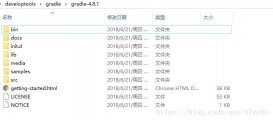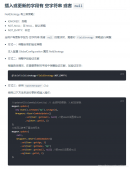背景
实际开发中,常常需要将比较复杂的 JSON 字符串转换为对应的 Java 对象。这里记录下解决方案。
如下所示,是入侵事件检测得到的 JSON 串:
[{"rule_id":"反弹shell","format_output":"进程 pname 反向连接到 %dest_ip%:%dest_port%","info":{"process_events":{"pid":21,"pname":"nginx","cmdline":"curl www.cfda.com","ppid":7,"ppname":"bash"},"proc_trees":[{"pid":21,"pname":"nginx","cmdline":"curl www.cfda.com","ppid":7,"ppname":"bash"}],"containers":{"container_id":"fef4636d8403871c2e56e06e51d609554564adbbf8284dd914a0f61130558bdf","container_name":"nginx","image_id":"4eb8f7c43909449dbad801c50d9dccc7dc86631e54f28b1a4b13575729065be8","status":"Running"},"sockets":{"src_ip":"127.0.0.1","src_port":"8080","type":"1","in_out":"0","dest_ip":"localhost","dest_port":"80"}}}]
方法
预备工作
把上述 json 串放在 src/test/resources 下,写一个文件读写程序来解析。 其实放在哪里不重要,重要的是拿到这个 JSON 串便于后续解析。
|
1
2
3
4
5
6
7
8
9
10
11
12
13
14
|
public static String readFromSource(String filename) { try { InputStream is = RWTool.class.getResourceAsStream(filename); byte[] bytes = new byte[4096]; int num = 0; String json = ""; while((num=is.read(bytes))>0){ json=new String(bytes,0,num); } return json; } catch (Exception ex) { throw new RuntimeException(ex.getCause()); }} |
构建对象模型
首先,要根据这个 JSON 字符串解析出对应的数据模型 AgentDetectEventData。主要就是按照 JSON 串中的 key 的层次结构来建立。
|
1
2
3
4
5
6
7
8
9
10
11
12
13
14
15
16
17
18
19
20
21
22
23
24
25
26
27
28
29
30
31
32
33
34
35
36
37
38
39
40
41
42
43
44
45
46
47
48
49
50
51
52
53
54
55
56
57
58
59
60
61
62
63
64
65
66
67
68
69
70
71
72
73
74
75
76
77
78
79
80
81
82
83
84
85
86
87
88
89
90
91
92
93
94
95
96
97
98
99
100
101
102
103
104
105
|
@Getter@Setterpublic class AgentDetectEventData { @SerializedName("rule_id") @JsonProperty("rule_id") private String ruleId; @SerializedName("format_output") @JsonProperty("format_output") private String formatOutput; @SerializedName("info") @JsonProperty("info") private AgentDetectEventDetail info;}@Getter@Setterpublic class AgentDetectEventDetail { @SerializedName("process_events") @JsonProperty("process_events") private ProcessEvent processEvent; @SerializedName("proc_trees") @JsonProperty("proc_trees") private List<ProcessTree> procTree; @SerializedName("containers") @JsonProperty("containers") private Container container; @SerializedName("sockets") @JsonProperty("sockets") private Socket socket;}@Getter@Setterpublic class ProcessEvent { @SerializedName("pid") @JsonProperty("pid") private String pid; @SerializedName("pname") @JsonProperty("pname") private String pname; @SerializedName("cmdline") @JsonProperty("cmdline") private String cmdline; @SerializedName("ppid") @JsonProperty("ppid") private String ppid; @SerializedName("ppname") @JsonProperty("ppname") private String ppname;}@Getter@Setterpublic class ProcessTree { @SerializedName("pid") @JsonProperty("pid") private String pid; @SerializedName("pname") @JsonProperty("pname") private String pname; @SerializedName("cmdline") @JsonProperty("cmdline") private String cmdline; @SerializedName("ppid") @JsonProperty("ppid") private String ppid; @SerializedName("ppname") @JsonProperty("ppname") private String ppname;}@Getter@Setterpublic class Container { @SerializedName("container_id") @JsonProperty("container_id") private String containerId; @SerializedName("container_name") @JsonProperty("container_name") private String containerName; @SerializedName("image_id") @JsonProperty("image_id") private String imageId; @SerializedName("status") @JsonProperty("status") private String status;}@Getter@Setterpublic class Socket { @SerializedName("src_ip") @JsonProperty("src_ip") private String srcIp; @SerializedName("src_port") @JsonProperty("src_port") private String srcPort; @SerializedName("type") @JsonProperty("type") private String type; @SerializedName("in_out") @JsonProperty("in_out") private String inOut; @SerializedName("dest_ip") @JsonProperty("dest_ip") private String destIp; @SerializedName("dest_port") @JsonProperty("dest_port") private String destPort;} |
这里有两个注意点:
- JSON 字符串的字段命名是下划线形式,而 Java 对象的属性命名是驼峰式的,这里需要做一个字段名映射转换。 使用 Jackson 库来转换,是 @JsonProperty 注解; 使用 gson 库来转换,是 @SerializedName 注解。
- 需要加 getter / setter 方法。
对象模型建立后,就成功了一大半。接下来,就是使用 json 库来解析了。
使用jackson 库解析
|
1
2
3
4
5
6
7
8
9
10
11
12
13
14
15
16
17
18
19
20
21
22
23
24
25
26
27
28
29
30
31
32
33
34
35
36
37
38
39
40
41
42
43
44
45
46
47
48
49
50
51
52
53
54
55
56
57
58
59
60
61
62
63
|
public class JsonUtil { private static Logger logger = LoggerFactory.getLogger(JsonUtil.class); private static final ObjectMapper MAPPER = new ObjectMapper(); static { // 为保持对象版本兼容性,忽略未知的属性 MAPPER.configure(DeserializationConfig.Feature.FAIL_ON_UNKNOWN_PROPERTIES, false); // 序列化的时候,跳过null值 MAPPER.getSerializationConfig().setSerializationInclusion(JsonSerialize.Inclusion.NON_NULL); // date类型转化 SimpleDateFormat fmt = new SimpleDateFormat("yyyy-MM-dd HH:mm:ss"); MAPPER.setDateFormat(fmt); } /** * 将一个json字符串解码为java对象 * * 注意:如果传入的字符串为null,那么返回的对象也为null * * @param json json字符串 * @param cls 对象类型 * @return 解析后的java对象 * @throws RuntimeException 若解析json过程中发生了异常 */ public static <T> T toObject(String json, Class<T> cls) { if (json == null) { return null; } try { return MAPPER.readValue(json, cls); } catch (Exception e) { throw new RuntimeException(e.getCause()); } } public static <T> String objectToJson(T obj){ if(obj == null){ return null; } try { return obj instanceof String ? (String) obj : MAPPER.writeValueAsString(obj); } catch (Exception e) { return null; } } public static <T> T jsonToObject(String src, TypeReference<T> typeReference){ if(StringUtils.isEmpty(src) || typeReference == null){ return null; } try { return (T)(typeReference.getType().equals(String.class) ? src : MAPPER.readValue(src, typeReference)); } catch (Exception e) { logger.warn("Parse Json to Object error",e); throw new RuntimeException(e.getCause()); } } public static <T> T jsonToObject(String src, Class<?> collectionClass,Class<?>... elementClasses){ JavaType javaType = MAPPER.getTypeFactory().constructParametricType(collectionClass,elementClasses); try { return MAPPER.readValue(src, javaType); } catch (Exception e) { logger.warn("Parse Json to Object error",e); throw new RuntimeException(e.getCause()); } }} |
单测:
|
1
2
3
4
5
6
7
8
9
10
11
12
13
14
|
public class JsonUtilTest { @Test public void testParseJson() { String json = RWTool.readFromSource("/json.txt"); List<AgentDetectEventData> ade = JsonUtil.jsonToObject(json, new TypeReference<List<AgentDetectEventData>>() {}); Assert.assertNotNull(ade); } @Test public void testParseJson2() { String json = RWTool.readFromSource("/json.txt"); List<AgentDetectEventData> ade = JsonUtil.jsonToObject(json, List.class, AgentDetectEventData.class); Assert.assertNotNull(ade); }} |
引入POM依赖为:
|
1
2
3
4
5
|
<dependency> <groupId>org.codehaus.jackson</groupId> <artifactId>jackson-mapper-asl</artifactId> <version>1.9.4</version></dependency> |
使用GSON解析
|
1
2
3
4
5
6
7
8
9
10
11
12
13
14
15
16
|
public class GsonUtil { static GsonBuilder gsonBuilder = null; static { gsonBuilder = new GsonBuilder(); gsonBuilder.setDateFormat("yyyy-MM-dd HH:mm:ss"); } public static Gson getGson() { return gsonBuilder.create(); } public static <T> T fromJson(String json, Class<T> cls) { return getGson().fromJson(json, cls); } public static <T> T fromJson(String json, Type type) { return getGson().fromJson(json, type); }} |
单测:
|
1
2
3
4
5
6
7
8
|
public class GsonUtilTest { @Test public void testParseJson() { String json = RWTool.readFromSource("/json.txt"); List<AgentDetectEventData> ade = GsonUtil.fromJson(json, new TypeToken<List<AgentDetectEventData>>(){}.getType()); Assert.assertNotNull(ade); }} |
引入 POM 为:
|
1
2
3
4
5
|
<dependency> <groupId>com.google.code.gson</groupId> <artifactId>gson</artifactId> <version>2.3.1</version></dependency> |
不含列表的嵌套对象
如果是不含列表的嵌套对象,则使用带 Class cls 入参的方法:
|
1
2
3
4
5
6
7
8
9
10
11
12
|
@Testpublic void testParseSimpleNestedJson() { String json = "{\"goods\":{\"desc\":\"2箱*250g\",\"goodsId\":8866,\"orderNo\":\"E20210522120237009258\",\"shopId\":659494,\"title\":\"认养一头牛\"},\"order\":{\"bookTime\":1621656157,\"codPay\":false,\"deliveryType\":\"express\",\"orderNo\":\"E20210522120237009258\",\"shopId\":659494,\"userId\":1476}}"; BookInfo bookInfo = JsonUtil.toObject(json, BookInfo.class); Assert.assertNotNull(bookInfo);}@Testpublic void testParseSimpleNestedJson() { String json = "{\"goods\":{\"desc\":\"2箱*250g\",\"goodsId\":8866,\"orderNo\":\"E20210522120237009258\",\"shopId\":659494,\"title\":\"认养一头牛\"},\"order\":{\"bookTime\":1621656157,\"codPay\":false,\"deliveryType\":\"express\",\"orderNo\":\"E20210522120237009258\",\"shopId\":659494,\"userId\":1476}}"; BookInfo bookInfo = GsonUtil.fromJson(json, BookInfo.class); Assert.assertNotNull(bookInfo);} |
读者可以自行解析出 BookInfo 的对象模型。
以上为个人经验,希望能给大家一个参考,也希望大家多多支持服务器之家。
原文链接:https://www.cnblogs.com/lovesqcc/p/14798434.html















